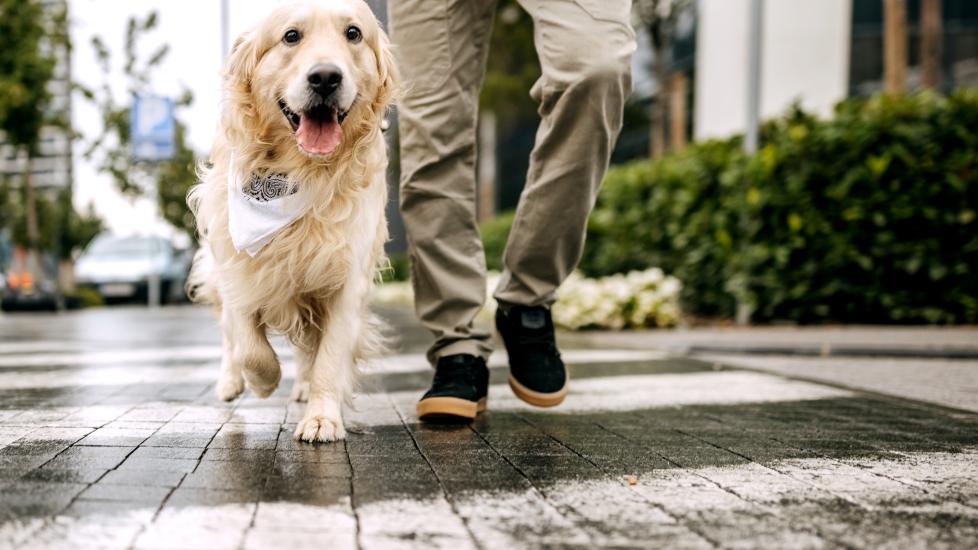Are Retractable Leashes Bad? 7 Risks and Which Leashes To Use Instead
Pet parents are always on the lookout for accessories to make activities like going on walks or hiking with their dog better. While retractable leashes might seem appealing for their ability to extend and retract at the press of a button, they might not be the safest for your dog.
What Is a Retractable Leash?
The retractable leash is made of a plastic handle that contains a spring-loaded spool of a thin rope, a flat tape, or a combination of the two. The line is coiled around the spool and controlled by a button on the handle.
The button controls the line’s length. When unlocked, it allows the line to extend and retract freely. In the locked position, the leash’s length is fixed regardless of tension or slack. The end of the leash has a traditional clip that attaches to the dog’s collar or harness.
Are Retractable Leashes Bad?
When choosing a leash for your dog, retractable leashes have risks and safety issues to consider.
1. They Can Lead To Injuries
The line cannot be retracted when there’s tension. If something happens, like if your dog lunges into the street, and you must pull your dog back, you may have no choice but to grab the leash with your bare hands. But, because it’s so thin, the line is difficult to secure, and it can slide through your hands and easily cause a burn or cut on your hand.
If you lock the leash as the dog is running, it can cause an abrupt stop. This can cause the dog to jerk back on the leash and result in an injury to the neck or throat, which could result in neck pain or, in severe cases, a ruptured disk in the neck. Injury to the windpipe or trachea can also cause the dog to cough or have trouble breathing.
If your pet is in pain or having trouble breathing, visit the vet immediately.
2. They Can Malfunction or Break
A button, a torsion spring, and a plastic spool are the only things between your dog and dangerous situations. With a retractable leash, there’s a risk that the internal mechanism could jam or break, allowing the leash to become detached.
Once the mechanism jams, pet parents will be unable to retract the leash, giving their dog the ability to run ahead. The dog could also snap the line if they get enough momentum. This can be especially dangerous when walking in high-traffic areas. You also run the risk of losing your dog if they are able to take off without your control.
3. They Can Get Tangled
Slack and tension must be actively managed when using a retractable leash, and the line can easily become tangled. This makes on-leash interaction difficult. For example, if you encounter another person with a friendly dog, your pup could run in a circle and wrap the line around them, possibly injuring one or both dogs.
4. They’re Hard To See
These lines are difficult to see because they are thin and dark. Having slack on the leash that is just a few inches from the ground is a tripping hazard; pet parents and friendly strangers could fall.
5. They Are Easily Dropped
The design of the retractable leash’s handle can also be problematic. Some have thick handles and no extra grip. They are easily dropped and the noise of the hard plastic handle hitting the ground can easily spook timid pups. A scared dog may run, dragging the handle behind them, thinking they are being chased.
6. They’re Not a Good Fit for Frightened Dogs
Fearful dogs are especially at risk; they can become scared if they accidentally tangle themselves in the leash. They may try to run or escape by backing out of their collar. And in the event of a dropped handle, these dogs could be frightened by the loud noise and run to try to get away.
7. They Can Reinforce Pulling
There’s a misconception that retractable leashes prevent pulling by giving dogs more freedom. The opposite is true. When dogs are walked on retractable leashes, the tendency is to release more of the line when the dog starts to pull forward.
When the line is released at the first sign of tension, pulling is reinforced and the dog learns that pulling works to get more freedom. Once the dog is at the end of the line, they will become frustrated and will pull harder. This is an impossible situation for pet parents because they are both out of line and have no way to retract the lead.
What Is the Best Alternative to a Retractable Leash?
In general, look for a leash made of a thicker material like nylon or neoprene that comes in a fixed length. Thicker leashes won’t cut into bare or furry skin.
The best leash for your dog is based on your situation. For urban areas, select a leash length that will keep your dog closer to you, like a standard 6-foot leash. The closer they are, the easier it is to reinforce them to walk near you.
In spacious environments like a beach or large park, try a long training line. They come in various lengths ranging from 10 feet up to 50 or even 100 feet. Once you learn some simple techniques to manage the slack as you walk, these will allow you to secure your dog when needed and give them freedom when it’s safe.
In short, walking your dog on standard leashes instead of a retractable leash will allow your pup a sense of freedom—without all the risks.
Featured Image: Pekic/E+ via Getty Images
